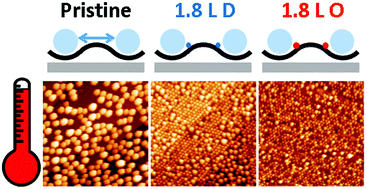Preventing sintering of nanoclusters on graphene by radical adsorption†
Abstract
Metal nanoclusters, supported on inert substrates, exhibiting well-defined shapes and sizes in a broad range of temperatures are a major object of desire in nanotechnology. Here, a technique is presented that improves the thermal stability of monodisperse and crystalline transition metal nanoclusters grown in a regular array on metal-supported graphene. To stabilize the clusters after growth under ultrahigh vacuum the system composed of the aggregates and the graphene/metal interface is exposed to radicals resulting from the dissociation of diatomic gases. As a model system we have used Pt as the metal element for cluster growth and the template consisting of the moiré pattern resulting from the lattice mismatch between graphene and the Ir(111) surface. The study has been performed for deuterium and oxygen radicals, which interact very differently with graphene. Our results reveal that after radical exposure the thermally activated motion of Pt nanoclusters to adjacent moiré cells and the subsequent sintering of neighbor aggregates are avoided, most pronounced for the case of atomic O. For the case of D the limits of the improvement are given by radical desorption, whereas for the case of O they are defined by an interplay between coalescence and graphene etching followed by Pt intercalation, which can be controlled by the amount of exposure. Finally, we determined the mechanism of how radical adsorption improves the thermal stability of the aggregates.



 Please wait while we load your content...
Please wait while we load your content...